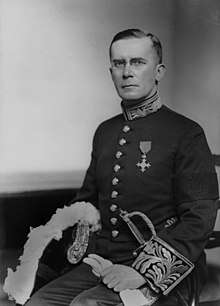Thomas Cooper, 1st Baron Cooper of Culross
Thomas Mackay Cooper, 1st Baron Cooper of Culross PC KC FRSE (24 September 1892 – 15 July 1956) was a Scottish Unionist Party politician, a judge and a historian, who had been appointed Lord Advocate of Scotland.[1]

Background and education

Cooper was the son of John Cooper, of Edinburgh, a civil engineer, and Margaret, daughter of John Mackay, of Dunnet, Caithness. In 1915 he applied to George Watson's College, Edinburgh, and the University of Edinburgh[2] where he completed an MA in 1912[3] and a Law LLB.
Political, legal and judicial career
Cooper was admitted a member of the Faculty of Advocates in 1915 and created a King's Counsel in 1927.[4] He was the Unionist Member of Parliament (MP) for Edinburgh West from a by-election in 1935 to 1941.[2][5] In 1935 he was appointed Solicitor General for Scotland[6] and later that year he was appointed as Lord Advocate.[7][8] He also became a Privy Counsellor in 1935.[9] In 1941 he became Lord Justice Clerk with the judicial title of Lord Cooper[10][11][12] and in 1947 Lord Justice General and Lord President of the Court of Session.[13][2]
He resigned in 1954 and was made a peer as Baron Cooper of Culross, of Dunnet in the County of Caithness.[14]
Personal life
Cooper was married to Margaret Mackay.
He was elected a Fellow of the Royal Society of Edinburgh in 1936, his proposers being John Alexander Inglis, Thomas Henry Holland, Thomas Hudson Beare and Ernest Wedderburn. He served as the Society's Vice President from 1945 to 1948.[15]
Death
Lord Cooper of Culross died in July 1956, aged 62, at which point the barony became extinct.[2] He is buried with his parents near the centre of the SW section of the original Grange Cemetery in south Edinburgh.
See also
References
- Taylor, Alice (2016). The Shape of the State in Medieval Scotland, 1124-1290. ISBN 9780198749202.
- thepeerage.com Thomas Mackay Cooper, 1st and last Baron Cooper of Culross
- Mackay, Cooper, Thomas (1912). "History of the island of Rhodes". hdl:1842/20913. Cite journal requires
|journal=(help) - "No. 33264". The London Gazette. 8 April 1927. p. 2310.
- leighrayment.com House of Commons: Ealing to Elgin
- "No. 15174". The Edinburgh Gazette. 17 May 1935. p. 424.
- "No. 15222". The Edinburgh Gazette. 1 November 1935. p. 913.
- "No. 34215". The London Gazette. 1 November 1935. p. 6900.
- "No. 34224". The London Gazette. 29 November 1935. p. 7575.
- "No. 15820". The Edinburgh Gazette. 13 June 1941. p. 305.
- "No. 35190". The London Gazette. 13 June 1941. p. 3376.
- "Lord Justice Clerk Appointed". The Times (48945). London, England. 6 June 1941. p. 4. Retrieved 18 January 2016 – via The Times Digital Archive.
- "No. 16401". The Edinburgh Gazette. 7 January 1947. p. 7.
- "No. 40246". The London Gazette. 3 August 1954. p. 4523.
- https://www.royalsoced.org.uk/cms/files/fellows/biographical_index/fells_indexp1.pdf
External links
- Hansard 1803–2005: contributions in Parliament by Thomas Cooper
| Parliament of the United Kingdom | ||
|---|---|---|
| Preceded by Wilfrid Normand |
Member of Parliament for Edinburgh West 1935–1941 |
Succeeded by Sir Ian Clark Hutchison |
| Legal offices | ||
| Preceded by Douglas Jamieson |
Solicitor General for Scotland 1935 |
Succeeded by Albert Russell |
| Preceded by Douglas Jamieson |
Lord Advocate 1935–1941 |
Succeeded by James Reid |
| Preceded by Lord Aitchison |
Lord Justice Clerk 1941–1947 |
Succeeded by Lord Thomson |
| Preceded by Lord Normand |
Lord Justice General 1947–1954 |
Succeeded by Lord Clyde |
| Peerage of the United Kingdom | ||
| New creation | Baron Cooper of Culross 1954–1955 |
Extinct |